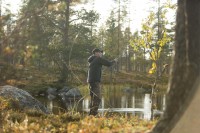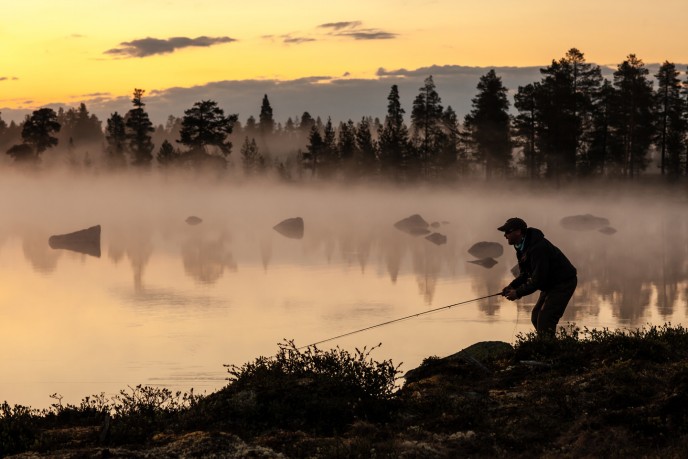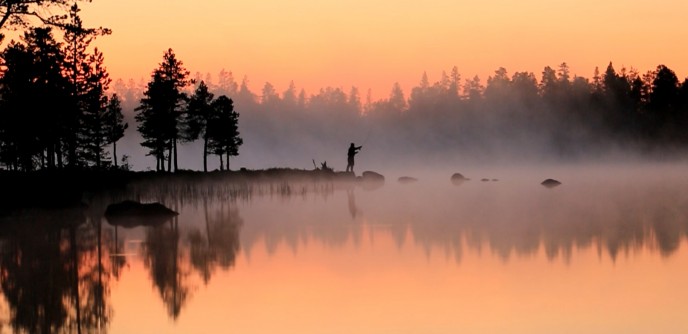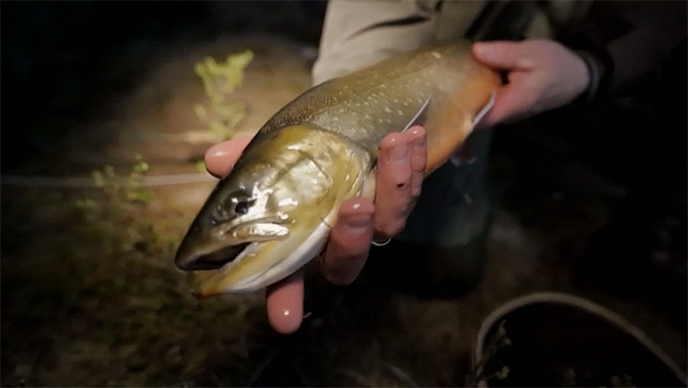
Spring fishing for arctic char
Sunrise foto: Anders Dahl Eriksen
For one or two weeks, the large arctic char pull towards the banks to feast on mayfly nymphs. We are fishing for arctic char in Femundsmarka.
Text: Anders Dahl Eriksen
Leptophlebia Vespertina is name of a 10 mm mayfly, which as a nymph starts to move about in the water column in the start of june. This makes the arctic char start to patrolling the shallows in search for swimming nymphs.
 There is quite a few really good char-waters in the whole Rendalen, Engerdal and Femund area. Some contain large fish. The waters are governed and cultivated by Engerdal Fjellstyre. The arctic chars is a challenge to catch to begin with, and for imitation specialist this fish will drive you nuts. It has a lot more to do about timing and presentation than it has to do with imitation.
There is quite a few really good char-waters in the whole Rendalen, Engerdal and Femund area. Some contain large fish. The waters are governed and cultivated by Engerdal Fjellstyre. The arctic chars is a challenge to catch to begin with, and for imitation specialist this fish will drive you nuts. It has a lot more to do about timing and presentation than it has to do with imitation.
Frustration
During the Leptophlebia fishing the char is only focused on the nymphs. It’s no point to serve them anything else. The most important thing is timing and presenting the fly in the path of the fish. The char seem unwilling to stray from its set path. You need to spend time observing it to better determine where to present the leptophlabien snack.

Early evening and no luck, photo by Matt Hayes
Variation in between waters
The lakes vary a lot in how the char behave, and to get this fishing going, you need a good dose of patience and willingness to observe how the char behaves. Either way for this type of fishing it seems to be the last week of may or the first week of june. You could also say two weeks after the ice melts.
Tekniques
The leptophlebia vespertina nymph swims up and sinks back down about 20 cm, only to repeat the behavior. It’s this dancing motion that seems to trigger the chars relentless patrolling of the shallows.

Morning mist photo by Matt Hayes
I have by no means cracked the code on how to best imitate it, but the best I’ve done this far is learned by locals. It consists of suspending an ordinary Sawyers pheasant tail nymph with shaggy body, under a buoyant dry fly. Pull it back in with careful jerks. You don’t want the dryfly to make much ripple, or maybe you do – who knows?

The twilight magic is nice either way photo: Anders Dahl Eriksen
Another technique is to use a light nymph with no dry fly, and retrieve it with a jerking motion.
The weather needs to be calm – preferably still, or find a calm bay. With that said, char fishing seems to be the mother of all fishing theories, and you’re bound to get lost in them.
Later in the season you catch them on noisy caddis, terrestrials and what not – but we will cover that in due time.
I’d like to send a special thanks Jan Lillestu for all the tips. I’m non the wiser – and still trying.
Anders

